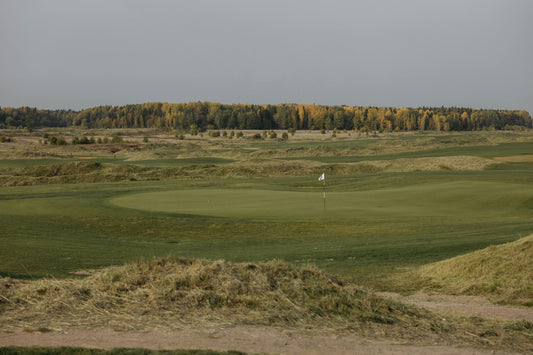You're standing over a 25-footer. The pin's tucked front-left, and there's a slope behind the hole that could send an aggressive putt racing six feet past. Do you go for it?
The answer depends almost entirely on where that flag sits.
Understanding how pin location should dictate your putting strategy will shave strokes off your score and eliminate those round-killing three-putts.
Years on the course have taught me this: the best putters aren't inherently aggressive or conservative. They're analytical. They read the situation, weigh the risk, and make calculated decisions based on pin placement.
Understanding Pin Position Zones
Think of the green in thirds: front, middle, and back. Do the same horizontally: left, center, and right. These create nine distinct zones where a pin might sit, each with different risk-reward characteristics.
Pin position controls your margin for error. A flag tucked front-right on a green sloping back-to-left presents completely different challenges than a center-cup position. Recognizing these differences separates smart putters from reckless ones.
When to Attack: Green Light Situations
Some pin positions reward aggression. Take dead aim in these scenarios:
1. Center pins with minimal break. The hole sits in the middle of the green on relatively flat terrain. You've maximized your margin for error in every direction. Even misses leave manageable comeback putts.
2. Uphill putts regardless of pin location. Uphill is your ally. The slope decelerates the ball naturally. Miss long and you won't face a nightmare comebacker. Be bold when putting uphill. The consequences of aggression remain tolerable.
3. Pins with ample green behind them. Plenty of distance between you and disaster (slopes, bunkers, false edges) means attack mode. You can miss and still have a reasonable second putt.
How to execute aggressive putts:
-
Commit completely to your line and speed. Hesitation ruins aggressive attempts.
-
Plan for the ball to finish 12-18 inches past the hole. This keeps it on line.
-
Take one practice stroke matching your intended speed.
-
Trust your read and accelerate through the ball.
When to Play Smart: Yellow Light Situations
These require judgment and self-awareness:
1. Pins on ridges or plateaus. Holes cut on tiers punish aggression. Miss on the wrong side and you'll face a terrifying downhill comebacker, or worse, you'll tumble off the tier completely.
2. Moderate downhill putts. Gentle downhill slopes demand respect. You can still show some aggression, but reduce your speed. Plan for the ball to die at the hole instead of rolling 18 inches beyond.
Approach for yellow light putts:
-
Picture a three-foot circle around the hole. That's your target.
-
Prioritize speed over line.
-
Take two practice strokes (one aggressive, one conservative) then choose the middle ground.
-
Two-putting is success here.
When to Play Defense: Red Light Situations
Certain pins punish ambition. Learn to spot these danger zones:
1. Severe downhill putts to front pins. This is where scores balloon. Putting steeply downhill to a pin near the green's front edge requires maximum caution. Aggressive misses can roll off the putting surface or leave you facing an even faster comebacker.
2. Pins near severe slopes or falloffs. When a dramatic slope lurks just beyond the cup, treat it like water. The cost of aggression outweighs any benefit. Tour players sometimes leave these putts four feet short. They're making the correct decision.
3. Super-fast greens with tucked pins. Greens running 12+ on the stimpmeter with corner or edge pins require defensive thinking even from professionals. Lagging these putts is smart golf, not cowardice.
How to execute conservative putts:
-
Aim for the low side on breaking putts.
-
Visualize the ball dying as it reaches the hole.
-
Speed is everything. Line becomes secondary.
-
Accept that your next stroke will be for par.
The Bottom Line
Mastering this choice isn't about adopting an aggressive or conservative identity. It's about adaptability. Read the green, evaluate the pin position, consider what happens if you miss, then make the intelligent play.
Professional golfers don't sink every putt. But they avoid catastrophic mistakes. They know that sometimes playing conservatively is the bold choice. Your scorecard only records strokes, not style points.
Take an extra moment on the green to assess pin placement. Let it dictate your strategy. Your putting average will reflect the improved decision-making.





